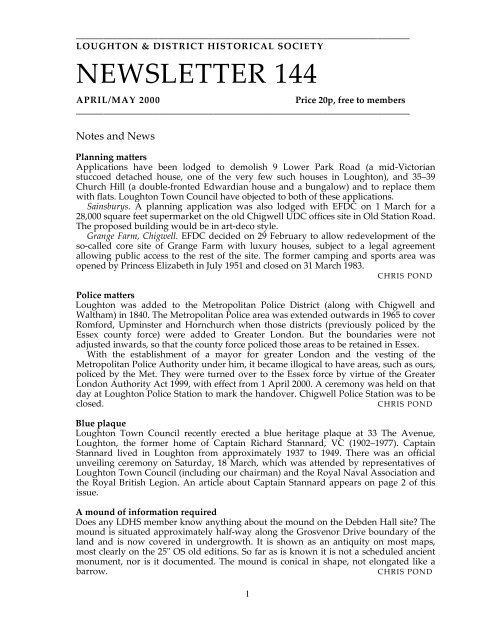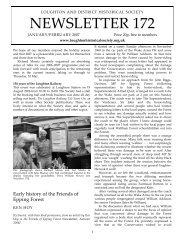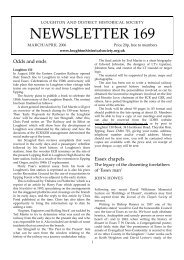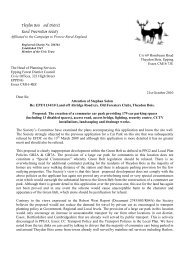NEWSLETTER 144 - Theydon Bois Village Web Site
NEWSLETTER 144 - Theydon Bois Village Web Site
NEWSLETTER 144 - Theydon Bois Village Web Site
You also want an ePaper? Increase the reach of your titles
YUMPU automatically turns print PDFs into web optimized ePapers that Google loves.
_________________________________________________________________________<br />
LOUGHTON & DISTRICT HISTORICAL SOCIETY<br />
<strong>NEWSLETTER</strong> <strong>144</strong><br />
APRIL/MAY 2000 Price 20p, free to members<br />
_________________________________________________________________________<br />
Notes and News<br />
Planning matters<br />
Applications have been lodged to demolish 9 Lower Park Road (a mid-Victorian<br />
stuccoed detached house, one of the very few such houses in Loughton), and 35–39<br />
Church Hill (a double-fronted Edwardian house and a bungalow) and to replace them<br />
with flats. Loughton Town Council have objected to both of these applications.<br />
Sainsburys. A planning application was also lodged with EFDC on 1 March for a<br />
28,000 square feet supermarket on the old Chigwell UDC offices site in Old Station Road.<br />
The proposed building would be in art-deco style.<br />
Grange Farm, Chigwell. EFDC decided on 29 February to allow redevelopment of the<br />
so-called core site of Grange Farm with luxury houses, subject to a legal agreement<br />
allowing public access to the rest of the site. The former camping and sports area was<br />
opened by Princess Elizabeth in July 1951 and closed on 31 March 1983.<br />
CHRIS POND<br />
Police matters<br />
Loughton was added to the Metropolitan Police District (along with Chigwell and<br />
Waltham) in 1840. The Metropolitan Police area was extended outwards in 1965 to cover<br />
Romford, Upminster and Hornchurch when those districts (previously policed by the<br />
Essex county force) were added to Greater London. But the boundaries were not<br />
adjusted inwards, so that the county force policed those areas to be retained in Essex.<br />
With the establishment of a mayor for greater London and the vesting of the<br />
Metropolitan Police Authority under him, it became illogical to have areas, such as ours,<br />
policed by the Met. They were turned over to the Essex force by virtue of the Greater<br />
London Authority Act 1999, with effect from 1 April 2000. A ceremony was held on that<br />
day at Loughton Police Station to mark the handover. Chigwell Police Station was to be<br />
closed. CHRIS POND<br />
Blue plaque<br />
Loughton Town Council recently erected a blue heritage plaque at 33 The Avenue,<br />
Loughton, the former home of Captain Richard Stannard, VC (1902–1977). Captain<br />
Stannard lived in Loughton from approximately 1937 to 1949. There was an official<br />
unveiling ceremony on Saturday, 18 March, which was attended by representatives of<br />
Loughton Town Council (including our chairman) and the Royal Naval Association and<br />
the Royal British Legion. An article about Captain Stannard appears on page 2 of this<br />
issue.<br />
A mound of information required<br />
Does any LDHS member know anything about the mound on the Debden Hall site? The<br />
mound is situated approximately half-way along the Grosvenor Drive boundary of the<br />
land and is now covered in undergrowth. It is shown as an antiquity on most maps,<br />
most clearly on the 25" OS old editions. So far as is known it is not a scheduled ancient<br />
monument, nor is it documented. The mound is conical in shape, not elongated like a<br />
barrow. CHRIS POND<br />
1
More on the British School<br />
Further to the report in Newsletter 143 about the Society opposing an application for outline<br />
planning permission to demolish the old British School in Smarts Lane and Chris Pond's note on<br />
the history of the school, Richard Morris, OBE, has kindly supplied a report of 1870 on the school.<br />
Matthew Arnold reported on Loughton British School in May 1870, Log Book of British School,<br />
Loughton:<br />
“The present master, an old pupil teacher of mine, came here in July last. Both the<br />
attendance and the instruction have during the winter been greatly affected by scarlet<br />
fever, but the numbers are now considerable. The order is satisfactory. The cause of<br />
illness being removed, the weakness of the instruction, now far too great must be<br />
remedied. The arithmetic is defective all through the School, and the spelling in the third<br />
and fourth standards. The answering in geography is good and this subject is taught in a<br />
way to interest the children. A competent person attends every afternoon to teach the<br />
girls needlework. The water is not yet laid on to the offices. The maps want renewing<br />
and they should be hung up in the schoolroom. My Lords will look for improvement as<br />
the condition of an unreduced grant another year."<br />
Source: English History from Essex Sources 1750–1900 (Essex Record Office, 1952).<br />
Local Hero – Captain Richard Stannard, VC, DSO, RNVR<br />
Mr Peter Tipler, Chairman of the Loughton Branch of the Royal Naval Association, has kindly<br />
contributed the following article on the life of Captain Stannard, a subject he has been researching<br />
since 1994:<br />
The Norway Campaign was not one of the successes of the War and the Navy was called<br />
in to evacuate troops from several points, among which was Namsos, about 100 miles<br />
north of Trondheim, where troops had been landed on 14 April 1940. Amongst the ships<br />
sent there were the 15th and 16th Anti-Submarine Striking Forces.<br />
These spendidly named forces were actually composed of four trawlers each, with<br />
Royal Naval Reserve officers and crews from the Royal Naval Patrol Service. Their duty<br />
was to patrol the fjords for submarines, but slow and lightly armed as they were, they<br />
made easy targets for the Stuka dive bombers, who soon made it impossible for them to<br />
operate in daylight.<br />
The 15th Anti-Submarine Striking Force, under Commander Sir Geoffrey Congreve,<br />
arrived at Namsos at 0200 on 28 April 1940. Lieutenant Richard Been Stannard, RNR,<br />
commanded HM Trawler Arab. A merchant seaman, he wore the interwoven gold rings<br />
of the Royal Naval Reserve on his jacket.<br />
Arab was ordered alongside the cruiser Carlisle to ferry stores and equipment from the<br />
ship to the shore. The first air raid began at daybreak when Arab was cast off from<br />
Carlisle and later secured alongside a jetty astern of a French ammunition ship Saumur.<br />
She was still there when another air raid began. A bomb landed on the jetty and set fire<br />
to many tons of hand grenades which had been disembarked.<br />
Lieutenant Stannard ran Arab's bows against the jetty and held her there by running<br />
the engines slow ahead. He sent all but two of his crew to comparative safety aft and<br />
then tried for two hours to put out the fire with Arab's hoses. He succeeded in saving<br />
part of the jetty, which was invaluable in the later evacuation.<br />
Arab spent the night of 28–29 April ferrying a battalion of 850 French troops from<br />
shore to ship before facing a long day of air attacks in which 16 near misses damaged<br />
Arab's rudder and propeller and cracked her main engine castings. Stannard had to find<br />
shelter by running Arab under the cover of some cliffs. The air attacks continued the<br />
next day. Stannard took his own crew and the crew of the damaged trawler Gaul ashore<br />
and set up an anti-aircraft gun position on the cliffs, where he beat off a succession of<br />
dive-bombing attacks. The next morning many of the men, including Stannard, were<br />
suffering from frost-bitten feet and Stannard had been wounded by a bullet. However,<br />
2
when a bomb hit the trawler Aston Villa and set her on fire, Stannard went back on board<br />
Arab and had moved her about 100 yards, just far enough off, before Aston Villa blew up.<br />
At last on 2 May, when the Namsos evacuation was almost complete, they were<br />
ordered to leave and as Stannard set Arab with her damaged engines gingerly going<br />
down the fjord, another vessel received a hit from a bomb and caught fire. Stannard took<br />
Arab alongside and took off her crew. At day break when they had barely cleared the<br />
entrance to the fjord a Heinkel 111 bomber appeared on the scene. The pilot signalled<br />
‘steer east [back to Namsos] or be sunk’. Stannard said later ‘he appeared to be a novice’<br />
and he flashed back what he called ‘a suitable answer in reply’. Stannard held his fire<br />
until the unwary pilot made a pass, banking over them at a range of 800 yards. Arab<br />
opened fire with every gun and the first burst brought the Heinkel spinning down into<br />
the sea. Stannard then brought Arab safely home in spite of her damaged engines.<br />
A few weeks later he would be at Dunkirk and again in the thick of the action. In his<br />
own words: ‘Dunkirk was a picnic compared to the hell of Namsos.’<br />
As his citation of 16 August 1940 said: ‘his continuous gallantry in the presence of the<br />
enemy was magnificent and his enterprise and resource not only caused losses to the<br />
Germans but saved his ship and many lives.’<br />
Arab survived 31 air attacks in five days at Namsos and, in a way, it was appropriate<br />
that when Stannard went to Buckingham Palace to receive his Victoria Cross from King<br />
George VI on 3 September 1940, the first anniversary of the outbreak of war, the<br />
ceremony was switched from the quadrangle to the great hall – because of an air raid!<br />
He was mentioned in dispatches in December 1940 for gallantry in command of Arab<br />
during an air raid on a convoy he was escorting when the SS Statira was bombed. By<br />
now he was Lieutenant Commander RNR.<br />
King Haakon awarded him the Norwegian War Cross on 19 October 1942 for his<br />
bravery at Namsos Wharf on 28 April 1940.<br />
Stannard was promoted Lieutenant Commander RNR on 29 June 1940 and then<br />
commanded HMS Ramsay, one of the 50 ex American destroyers, in 1941.<br />
In May 1943 he was back at Buckingham Palace to receive from the Queen the<br />
Distinguished Service Order for his part as captain of the destroyer Vimy which with<br />
Beverley sank U18 during a three-day and night running battle in the Atlantic beginning<br />
on 4 February 1943.<br />
Stannard went to sea as an apprentice in the Port Line ship Port Victor in 1918 and<br />
advanced from Fourth to Second Officer from 1922 to 1928. In March 1929 he joined the<br />
Orient Line and also became a probationary Sub Lieutenant RNR. Promoted Lieutenant<br />
RNR in 1932 and Second Officer in the Orient Line in 1937. After Arab and Vimy he<br />
commanded Peacock, Prince Henry and Stanley. He was promoted Commander RNR on<br />
30 June 1947 and left the Reserve in September, rejoining the Orient Line as Chief Officer<br />
and Staff Commander in 1949. He was promoted Captain RNR in May 1952.<br />
About this time the RNR (twisted and knotted) and the RNVR (wavy Navy) became<br />
one as the RNVR Permanent Reserve, so Stannard became Captain RNVR not RNR as<br />
throughout his wartime career.<br />
He survived a car crash in 1945 and moved to Australia and became Marine<br />
Superintendent of the P & O Orient Lines of Australia.<br />
The Royal Naval Patrol Service Museum at Lowestoft was opened by his surviving<br />
two daughters with his actual Victoria Cross in their possession. I believe one daughter<br />
lives in Australia and the other daughter lives in Surrey.<br />
Richard Been Stannard was the first RNR VC winner of the Second World War. He<br />
was born on 21 August 1902 at Blyth, Northumberland, one of three sons of Captain<br />
George Davis Stannard, Master Mariner, and Elizabeth Jane Stannard (née Knowles).<br />
His father's ship, Mount Oswald, was lost with all hands on a voyage from Baltimore in<br />
February 1912 and Richard and his brothers went to the Royal Naval Merchant School<br />
(in Essex and later in Wokingham, Berkshire) which was founded in 1827 for the<br />
orphans of merchant seamen.<br />
In 1928 at West Ham he married Phyllis May Tomkin, the daughter of G P Tomkin, a<br />
printer of Leytonstone, Essex. He lived at 33 The Avenue, Loughton, from 1937 till 1949<br />
and at Balmoral Heights, Sydney, New South Wales, where he died on 22 July 1977.<br />
The Royal Naval Patrol Service have a full-length portrait of him in their Museum at<br />
Lowestoft and consider him as their own special hero. We in Loughton consider him as<br />
our ‘Local Hero’.<br />
3
Rank Award Ship Action Investiture<br />
Lieut VC HMT Arab Namsos 3.9.40<br />
Lieut Cdr MID* HMT Arab SS Statira<br />
bombed<br />
N/A<br />
Lieut Cdr Nor War<br />
HMT Arab Namsos<br />
19.10.42<br />
Cross<br />
Wharf<br />
(28.4.40)<br />
Lieut Cdr DSO HMS Vimy Convoy SC<br />
118<br />
22.6.43<br />
Lieut Cdr MID HMS<br />
Psq<br />
N/A<br />
Peacock<br />
Convoy JW<br />
59<br />
*MID = mentioned in dispatches.<br />
PETER TIPLER (Chairman RNA Loughton Branch)<br />
Archaeology<br />
Peter Newton, in the Newsletter of the <strong>Theydon</strong> <strong>Bois</strong> and District Rural Preservation Society,<br />
reported that visits had been made to the Archaeological Department at County Hall, Chelmsford,<br />
and a record made of finds in the vicinity of <strong>Theydon</strong> <strong>Bois</strong>:<br />
Somewhere in the area of Loughton Lane and the Green a palæolithic flint hand axe was<br />
found. (The Palæolithic Period ended about 12000 BC.)<br />
On the site of Birch Hall, when the previous,Victorian, house was there, some bricks<br />
were found under the lawn which might have been Roman but no structures were<br />
discovered. Current Ordnance Survey maps show the presence of a well in ancient<br />
times. it is possible that there may have been a medieval moated house there, perhaps as<br />
part of a deserted medieval village. there is mention of the house of a ‘John ate Birches’<br />
in 1319 and Birch Hall is also referred to in 1542 and 1777.<br />
______________________________________________________________________________<br />
LOUGHTON & DISTRICT HISTORICAL SOCIETY Registered Charity No 287274<br />
President: J I Besent, OBE, FRICS, MRAC<br />
Chairman: Dr Chris Pond, Forest Villa, Staples Road, Loughton IG10 1HP (020 8508 2361)<br />
Secretary: John Howes, 97 Staples Road, Loughton IG10 1HR (020 8508 0776)<br />
Treasurer: Mrs Eve Lockington, 19 Spring Grove, Loughton IG10 4QB (020 8508 4995)<br />
Membership Secretary: Ian Strugnell, 22 Hatfields, Loughton IG10 1TJ<br />
Newsletter Editor: Ted Martin, 34 Hornbeam Road, <strong>Theydon</strong> <strong>Bois</strong> CM16 7JX (01992 8<strong>144</strong>45)<br />
All rights reserved. © 2000 Loughton & District Historical Society. Printed by Riverside Press, Ipswich<br />
_______________________________________________________________________________________________________<br />
4







